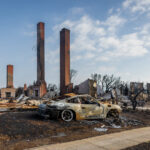A recent federal hearing on insurance fraud exploring the necessity of a federal fraud fighting program, highlighted how stakeholders work to address and fight the multi-billion dollar industry.
The Subcommittee on Consumer Protection, Product Safety, Insurance, and Data Security, held the hearing, “Insurance Fraud in America: Current Issues Facing Industry and Consumers” earlier this month.
Representatives of the Insurance Information Institute (I.I.I.), National Association of Insurance Commissioners (NAIC), Coalition Against Insurance Fraud (CAIF), National Insurance Crime Bureau (NICB) and the Consumer Federation of America (CFA) discussed the top issues facing consumers and insurers.
According to the chairman of the subcommittee, U.S. Senator Jerry Moran, the purpose of the hearing was to examine insurance fraud trends in the United States and explore tools available to states, insurers and consumers to protect against these crimes.
He added that nearly 3,000 property and casualty insurance companies across the U.S battle $40 billion in non-health insurance fraud each year.
Sean Kevelighan, I.I.I.’s chief executive officer, said property/casualty insurers paid out more than $327 billion in 2015 to settle claims.
Though insurance is largely regulated at the state level, Moran said that the federal government needs to protect consumers.
“Insurance fraud schemes can and do lead to federal criminal charges, and I believe the federal government must do what it can to protect consumers from bad actors who seek to defraud them,” said Moran.
Fraud Schemes
John Doak, currently the Oklahoma Insurance Commissioner who testified on behalf of the National Association of Insurance Commissioners (NAIC), said the current fraud trends the states are seeing involve contractor/adjuster fraud following natural disasters, opioid abuse/insurance fraud schemes and windshield replacement scams.
According to Tim Lynch, director of government affairs for the NICB, three key areas of fraud include medical fraud, vehicle crime and roofer/contractor fraud. He indicated several states – Colorado, Kentucky, Illinois, Indiana, Minnesota, Nebraska, Oklahoma and Texas – have taken action against roofer/contractor fraud by tightening consumer protections against these abuses.
Insurance fraud schemes continue to evolve and are increasingly getting more sophisticated, said Kevelighan, especially as online insurance transactions increase.
Dennis Jay, executive director of the Coalition Against Insurance Fraud, added that when pressure is applied in one hot area of fraud, crime rings tend to move operations to other regions.
States, Organizations Fight Back
With consumers and businesses spending more than $2 trillion on insurance per year, Doak said states have responded to insurance fraud using a multifaceted approach.
This approach involves educating consumers on reporting and preventing insurance fraud. Special fraud bureaus have been created in the insurance departments of 31 states and in the District of Columbia, said Doak, who added that 11 states have bureaus housed in the attorney general’s office, law enforcement agencies or another regulatory entity.
Doak said some states address insurance fraud through market conduct, consumer affairs or legal divisions.
He explained that the NAIC’s formation of the Antifraud Task Force in the 1980s, has aided in data collection and information-sharing efforts that are critical to fighting fraud.
In addition, he said the Task Force is working to develop uniform insurance fraud referral requirements to guide insurers in submitting data to state insurance departments.
Jay explained that while arrests and convictions are good, they won’t do anything to prevent fraud.
“More efforts must focus on prevention and deterrence. Public outreach messages can help convince otherwise honest consumers that they will a high price for cheating on insurance,” said Jay.
Anti-fraud technology is helping insurers fight fraud, he said, adding that good analytics can identify complex rings.
States are pulling their weight as well, Jay said, with solid anti-fraud initiatives.
“All states but two have enacted specific insurance fraud statutes to define fraudulent acts and set penalties. And 38 states have created agencies to investigate and prosecute insurance fraud. Most have police powers and several employ prosecutors to exclusively deal with insurance fraud cases,” Jay said.
Sharing claims data among property/casualty insurers has aided in the detection of suspected fraud, especially by organized rings, he said.
One example of sharing data is Healthcare Fraud Prevention Partnership (HFPP), in which public and private health insurers and other stakeholders share data about medical schemes.
“They’ve saved more than $300 million in fraud,” Jay said.
Medical rings that steal from federal health programs will often defraud auto and workers’ compensation insurers, he said.
Despite this connection, Jay said property/casualty insurers aren’t privy to the HFPP data because of HIPAA restrictions.
“This is a lost opportunity because many medical providers who defraud property/casualty insurers also file false claims against government health programs, and vice versa,” said Jay.
The NICB focuses on investigating organized insurance fraud and vehicle crime rings that file multiple claims and/or target multiple carriers, said Lynch.
Like Jay, he also emphasized the significant amount of crossover fraud impacting both property/casualty insurers and Medicare, Medicaid and private health insurance.
Protecting Consumers and Insurers
Rachel Weintraub, general counsel for the Consumer Federation of America, indicated the CFA is concerned about fraud by the insurance industry against consumers and fraud by consumers against the industry. She said bad faith, questionable auto insurance pricing, and storm chasers were just some examples of insurers committing fraud against consumers.
While insurer Special Investigative Units (SIUs) are an important tool in the fight against insurance fraud, she said there needs to be controls in place to monitor insurers. She cited an example of investigations going on for extensive periods of time while people are unable to return to their home because of a pending arson investigation.
“Frequently, these delays go on for an excessive period only to conclude with the finding that there was no fraud,” said Weintraub. “Steps must be taken to assure that insurer fraud investigations are completed in a timely way so innocent people are not left hanging, for example, without a place to live for month after month.”
Was this article valuable?
Here are more articles you may enjoy.

 Wall Street Brokers Start Trading Insurer Claims From LA Fires
Wall Street Brokers Start Trading Insurer Claims From LA Fires  The Evolution of Homeowners Insurance in California—From Niche to Necessity
The Evolution of Homeowners Insurance in California—From Niche to Necessity  Insurers Have Paid $12B in Claims for LA Wildfires, Report Shows
Insurers Have Paid $12B in Claims for LA Wildfires, Report Shows  Deutsche Bank, Mudrick Sue Ambac Over $65 Million Transfer
Deutsche Bank, Mudrick Sue Ambac Over $65 Million Transfer 